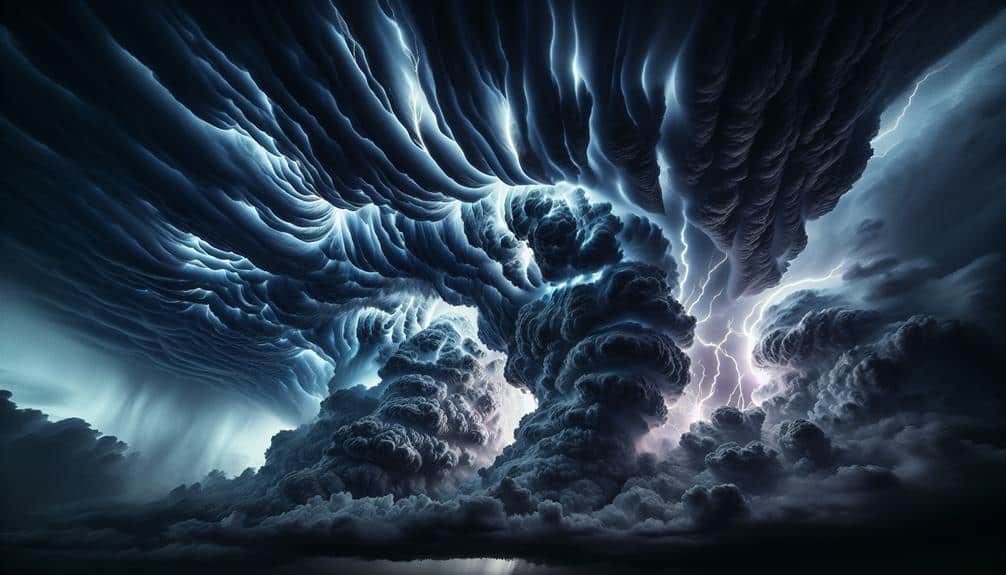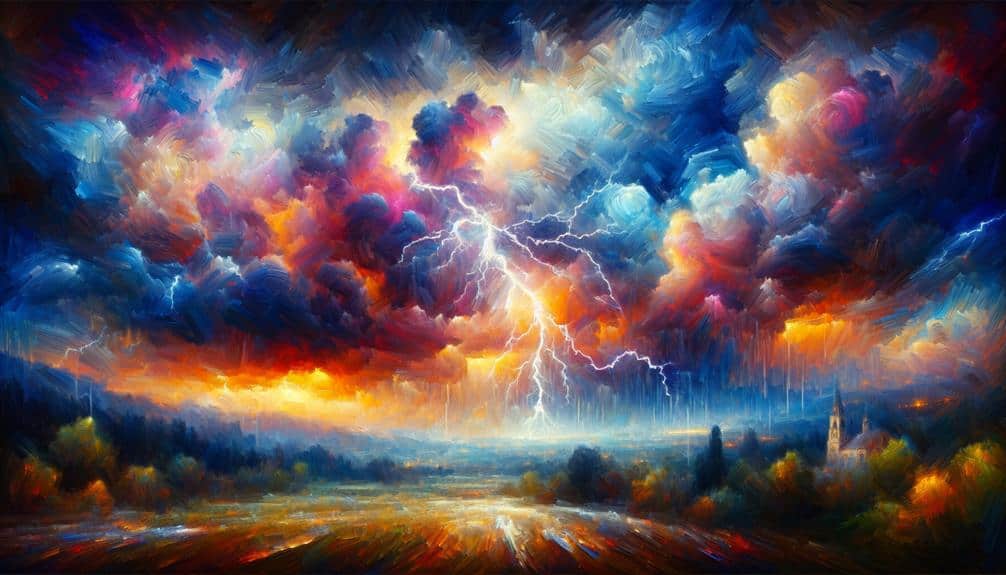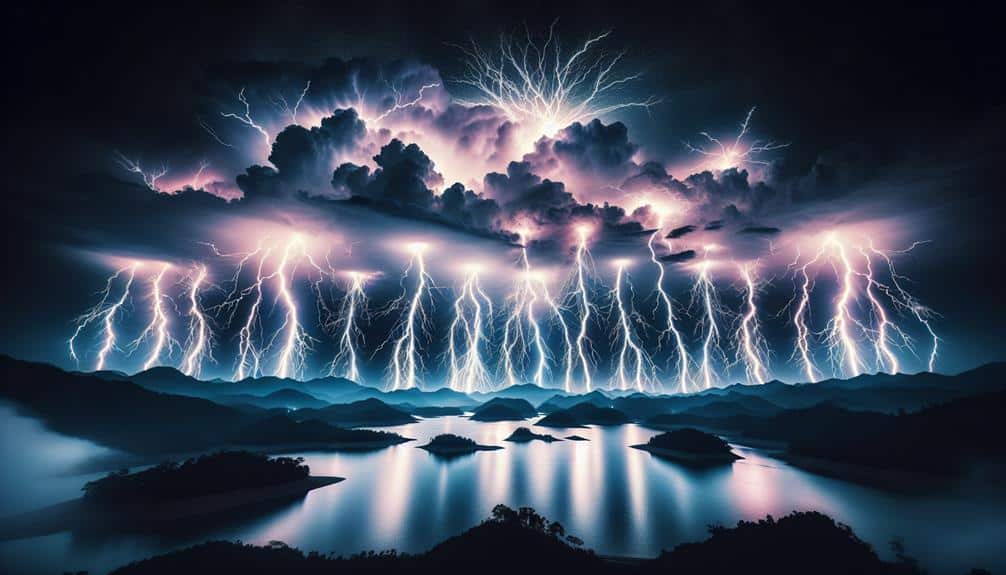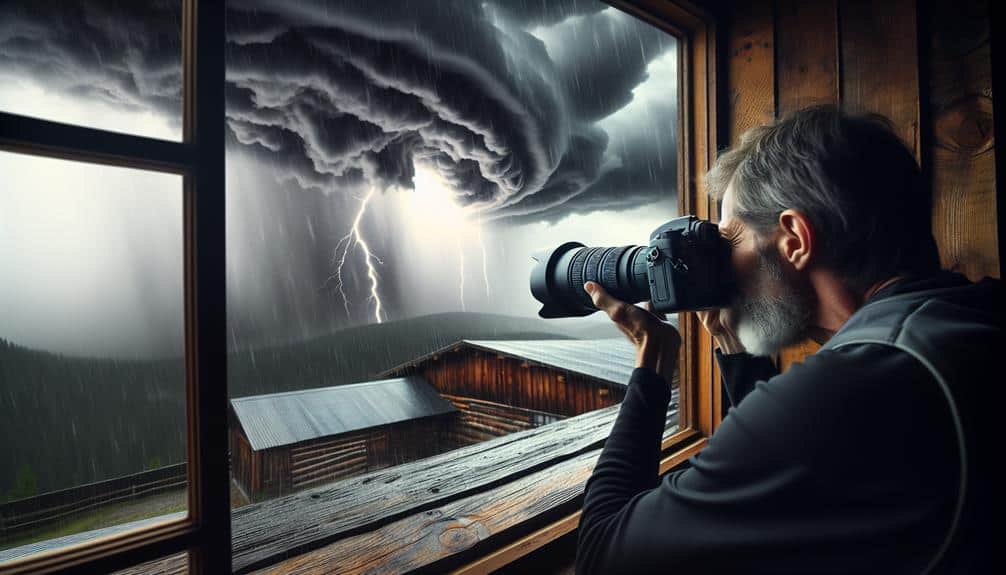We enhance storm photos with post-processing techniques to capture the true power and drama of these natural events. By adjusting exposure and fine-tuning highlights and shadows, we emphasize cloud formations and lightning. Color adjustments can correct light imbalances, boost visual impact, and reveal hidden layers. Removing distractions like power lines or debris refines the image, while adding clarity and artistic effects transforms our work into striking visual art. Enhancing contrast and sharpness brings out textures and details, making storm photos vivid and engaging. Discover how these techniques elevate our storm photography to new heights.
Key Points
- Enhances dramatic lighting and contrast for a more impactful visual experience.
- Emphasizes cloud formations and lightning to capture the storm's intensity.
- Corrects light imbalances and boosts colors for a dynamic range.
- Removes unwanted elements to focus on the storm's narrative.
Highlighting Dramatic Lighting
To highlight dramatic lighting in storm photos, we'll focus on enhancing the contrast and saturation to emphasize the interplay between light and shadow.
First, let's adjust the exposure. By slightly lowering the exposure, we can deepen the shadows, which helps in capturing the intense mood of the storm. This step is important for making the cloud formations and lightning stand out.
Next, we should fine-tune the highlights and shadows. Increasing the highlight levels brings out the brilliance in lightning strikes and bright spots in the clouds, while lowering the shadows makes the darker areas more pronounced. This contrast is necessary for creating mood and adding depth to the image.
We'll also pay attention to the midtones. Adjusting the midtones helps to balance the overall exposure, ensuring our storm photo retains detail in both the brightest and darkest areas. This step is essential for keeping the image dynamic and engaging.
Enhancing Color and Contrast
Let's start by boosting the visual impact of our storm photos through precise color adjustments and contrast enhancements.
By highlighting storm details and correcting light imbalances, we can transform a flat image into a mesmerizing scene.
Adjusting hue, saturation, and luminance allows us to emphasize the drama and intensity inherent in storm photography.
Boosting Visual Impact
Enhancing the color and contrast in storm photos can dramatically elevate their visual impact, transforming a good image into a breathtaking one. Through creative editing and visual storytelling, we can convey the raw power and beauty of nature's fury. Digital enhancements allow us to amplify atmospheric intensity, making the viewer feel as though they're standing right in the midst of the storm.
By adjusting colors and contrast, we can bring out the hidden details and textures that might otherwise go unnoticed. Here are a few key techniques:
- Saturation Boost: Amplifies the vividness of the storm clouds, making the scene more dramatic.
- Contrast Adjustment: Sharpens the boundaries between light and dark areas, highlighting the storm's dynamic range.
- Selective Color Editing: Enhances specific hues, like the eerie greens of a tornado or the electric blues of lightning.
These techniques not only make the images more visually striking but also help in telling a story. We can guide the viewer's eye to the most critical elements, creating an immersive experience that captivates and inspires awe.
Highlighting Storm Details
Focusing on the intricate details within storm photos, we can use color and contrast enhancements to reveal the hidden layers of atmospheric drama. By amplifying these elements, we bring out the storm movement and atmospheric textures that often go unnoticed in raw images.
When we tweak the color balance, we can make the ominous greens and purples more vivid, creating a dynamic composition that conveys the storm's intensity.
We start by adjusting the contrast to highlight the varying shades of clouds, making the lightning bolts or swirling formations stand out. This step is vital for capturing the storm's energy and movement. A well-adjusted contrast can transform a flat image into a striking display of nature's power, showcasing the intricate patterns and depths within the storm.
Next, we focus on color enhancements to bring out the subtle hues in the sky. By fine-tuning the saturation and vibrance, we can emphasize the brooding atmosphere and the interplay of light and shadow. These enhancements allow us to create a visual narrative that speaks to the viewer's sense of freedom and awe, making them feel as if they're standing right in the heart of the storm.
Correcting Light Imbalance
To correct light imbalances in storm photos, we meticulously adjust highlights and shadows, ensuring a balanced exposure that brings out the storm's dynamic range. This process involves precise color correction and exposure adjustment to capture the essence of the storm's ferocity and beauty. By focusing on shadow detail and highlight recovery, we create an image that truly reflects the storm's intensity.
Through careful manipulation, we aim to:
- Enhance cloud formations: Bringing out the intricate patterns and textures in the clouds.
- Illuminate foreground elements: Ensuring that elements like trees and buildings aren't lost in darkness.
- Accentuate lightning: Making sure the electric bolts cut through the sky with dramatic clarity.
Emphasizing Cloud Structures

When emphasizing cloud structures, we need to focus on highlighting cloud contours and enhancing dramatic lighting.
By adjusting the clarity and sharpening tools, we can bring out the intricate details of the cloud formations.
Let's also adjust the highlights and shadows to create a striking interplay of light that adds depth and intensity to our storm photos.
Highlight Cloud Contours
By adjusting the contrast and utilizing selective dodging and burning, we can dramatically enhance the intricate contours of storm clouds, revealing their majestic structures. This technique allows us to focus on enhancing texture details, which in turn captures the mood and emotion of the storm. The process involves meticulously adjusting brightness in specific areas to accentuate the depth and form of the clouds.
When we enhance these textures, we're not just making the clouds look more defined; we're telling a story through the image.
To create a vivid visual narrative, consider the following:
- Highlighting the edges of cumulus clouds to show their towering presence.
- Darkening the undersides of storm clouds to evoke a sense of impending weather.
- Bringing out the subtle gradients within the cloud layers to provide a three-dimensional effect.
Each adjustment we make is a creative decision that shapes the final image. By focusing on the contours, we not only create a visually appealing photograph but also evoke a powerful sense of drama and tension, immersing the viewer in the storm's raw and untamed nature.
Enhance Dramatic Lighting
Leveraging dramatic lighting, we can accentuate the cloud structures, making the storm's intensity and energy palpable in our photographs. By enhancing shadows and emphasizing highlights, we create a dynamic contrast that brings out the intricate details within the clouds. This technique transforms a flat image into a three-dimensional spectacle, enchanting viewers with its realism and grandeur.
To start, we must carefully adjust the exposure settings to balance the light and dark areas. Enhancing shadows helps reveal the depth and complexity of the storm clouds, while emphasizing highlights can make the brighter parts pop, adding a sense of excitement. Tools like the Dodge and Burn in photo editing software are invaluable for this purpose.
Next, creating depth involves refining the midtones and enhancing textures. By fine-tuning these elements, we can give the clouds a more tangible, almost touchable quality. Techniques such as clarity adjustments and selective sharpening can further enhance textures, making the storm appear more vivid.
In the end, these post-processing techniques allow us to capture not just an image, but the raw, untamed essence of the storm. Through our creative vision and technical expertise, we bring the freedom and power of nature to the forefront of our photos.
Removing Unwanted Elements
Eliminating distractions from storm photos can significantly enhance their visual impact and storytelling potential. When we strip away unnecessary elements, we're able to focus on adding drama and enhancing mood, which in turn creates a more compelling atmosphere. This process also contributes to improving composition, making the final image not just a picture, but a breathtaking narrative.
By removing unwanted elements, we can refine our photos to ensure every detail serves the larger story.
Here are some common distractions to contemplate eliminating:
- Power lines: These can disrupt the natural flow of a stormy sky, detracting from its raw intensity.
- Street signs: Often colorful and out of place, they can divert the eye away from the storm's grandeur.
- People or vehicles: Unless they add context or scale, they can clutter the image and reduce its dramatic impact.
Adding Artistic Effects

Incorporating artistic effects into storm photos can transform a simple capture into a powerful, evocative piece of visual art. By leveraging creative edits, we can accentuate the drama inherent in stormy skies. For instance, adjusting the color palette to enhance the blues and grays can amplify the storm's intensity, while desaturating certain areas can draw focus to the most dynamic elements.
Atmospheric enhancements are another crucial tool in our post-processing arsenal. By manipulating light and shadow, we can create a sense of depth and movement, making the storm feel more vivid and lifelike. Techniques such as dodging and burning can selectively lighten or darken areas, giving the clouds a more three-dimensional appearance. Adding subtle vignettes can guide the viewer's eye to the storm's epicenter, heightening the emotional impact.
Let's not forget the power of texture overlays. By layering cloud or rain textures, we can add a tactile quality that makes the photo almost palpable. These artistic choices not only highlight the raw power of nature but also allow us to infuse our personal vision and emotional response into each shot, creating truly unique works of art.
Improving Overall Clarity
When we aim to improve the overall clarity of our storm photos, starting with precise adjustments to contrast and sharpness can make a significant difference in revealing intricate details. By increasing sharpness, we can emphasize the texture of storm clouds, making the turbulent atmosphere more palpable.
Adjusting exposure helps us balance the light and dark areas, ensuring that no detail gets lost in shadows or blown-out highlights.
To bring out the full potential of our storm images, we should focus on:
- Enhancing edge definition: This helps to distinguish the swirling patterns of clouds and the jagged lines of lightning.
- Balancing exposure levels: Ensuring neither the darkest shadows nor the brightest highlights lose detail.
- Refining contrast: This intensifies the dynamic range, making elements like rain streaks and wind-swept landscapes stand out vividly.
Frequently Asked Questions
What Software Is Best for Post-Processing Storm Photos?
Did you know 68% of pro photographers prefer Lightroom vs Photoshop for storm photos? Lightroom offers efficient photo editing techniques, while Photoshop excels in creative vision. Both provide freedom to enhance our storm captures with technical expertise.
How Much Time Should I Spend on Post-Processing a Single Photo?
We should balance time management and efficiency with our creative choices to maximize impact. Spending 30-60 minutes per photo allows us to refine details without sacrificing creativity or freedom. This guarantees each image truly captivates.
Can Post-Processing Alter the Authenticity of Storm Photos?
We're walking a tightrope between authenticity concerns and creative expression. Post-processing can indeed alter the authenticity of storm photos, raising ethical implications, but it also allows for artistic interpretation, enhancing our creative vision and technical expertise.
Are There Any Ethical Considerations in Post-Processing Storm Images?
We must consider ethical implications when engaging in photo manipulation. While digital editing can enhance storm photos, maintaining truthfulness is essential. Our creative vision shouldn't distort reality, ensuring our audience receives an authentic representation of nature's power.
What Are Some Common Mistakes to Avoid During Post-Processing?
In the post-processing domain, a common error is over-saturating colors, which distorts reality. Quick fixes include balancing exposure and avoiding excessive sharpening. Let's guarantee our creative vision remains true to the storm's raw power.


